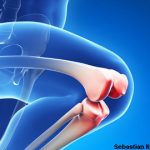Knee osteoarthritis is an indicator for total knee replacement surgery, the demand for which has increased worldwide with an aging population and higher obesity rates. Previous studies have shown that some patients continue to experience pain, physical limitations and muscle strength deficits after surgery.
To gain insight into this finding, Genevieve Fleeton, BPHty (Hons), and colleagues from the University of Sydney in Australia, examined the prevalence of the symptom of self-reported knee instability—the sensation of shifting, buckling or giving way of the knee—in patients both before and after total knee replacement surgery. Using physical performance measures and questionnaires, they evaluated self-reported knee instability and pain in 390 patients undergoing primary unilateral total knee replacement surgery with the goal of identifying potential modifiable risk factors for post-operative instability and pain. The results of their study were published in the April 2016 issue of Arthritis Care & Research.
This study was performed as a secondary analysis during a larger clinical trial examining rehabilitation and care after total knee replacement surgery for patients who were recruited between September 2009 and October 2012. Researchers worked with 390 participants who were 45–75 years old. Participants completed the Self-Administered Comorbidity Questionnaire. To evaluate pain and physical function, patients rated both knees using the Western Ontario and McMaster Universities Osteoarthritis Index (WOMAC). The Activities of Daily Living Scale of Knee Outcome Surgery was used to rate the prevalence of knee slipping/partial giving away and knee buckling/full giving away. Participants also underwent further physical performance measurements designed to evaluate stair-climb power, 50 foot walk time, maximal isometric knee flexion and extension strength, and knee range of motion.
Assessments were conducted presurgery (baseline), at six weeks and at six months post-surgery.
The Results
“Almost a third of participants who reported instability prior to surgery retained instability,” write the authors in their discussion. “This finding was surprising, given that most people would assume [total knee replacement] surgery would resolve this symptom.”
Of the original 390 participants, 323 had complete data from baseline through six months post-surgery, with 234 (72%) reporting knee instability at baseline. Six months later, 74 (32%) of these participants had continued knee instability.
Overall, the participants had an average age of 65.1, body mass index of 32.1 +/- 5.8 and a comorbidity score of 4.0 +/- 3.2. “The prevalence of diabetes mellitus, depression, back pain and anemia was higher among participants who retained instability, compared with those with no instability or resolved instability,” write the authors.
Compared with participants reporting no knee instability six months after surgery, the study found, “participants retaining instability in the operated knee at six months after surgery had significantly more knee pain and activity limitation, reduced lower-limb power, increased 50 foot walk time and reduced knee extensor strength.”
In the analysis, the stair-climb power test, which had higher demands on the knee and muscles, was the only physical performance measure to demonstrate an independent predictor for retaining knee instability. “Interestingly, the more functional test of lower-limb muscle power (i.e., stair-climbing power) did differ between our groups with and without knee instability,” write the authors. “No previous studies have assessed the role of muscle power in knee stability.”
Additionally, researchers cite comorbidities as a factor in “the cycle of inactivity and physical deconditioning, limiting optimal outcomes post surgery” for this patient group.
For pain evaluation, participants who continued to have knee instability reported greater preoperative and post-operative pain at six weeks and six months compared with other study participants. The mean difference was clinically meaningful, with 2.1 out of 20 for pain and 7.4 out of 68 for self-reported physical function on the WOMAC index.
“Screening for the presence of self-reported knee instability should be conducted prior to [total knee replacement] surgery and monitored throughout the post-surgery rehabilitation period,” write the authors. They conclude their study by calling for more research on specific interventions that will effectively address lower-extremity muscle strength and knee pain to minimize the effects of self-reported knee instability on patients after surgery.
Fleeton G, Harmer AR, Nairn L, et al. Self-reported knee instability before and after total knee replacement surgery. Arthritis Care Res (Hoboken). 2016 Mar 24. doi: 10.1002/acr.22692. [Epub ahead of print]

